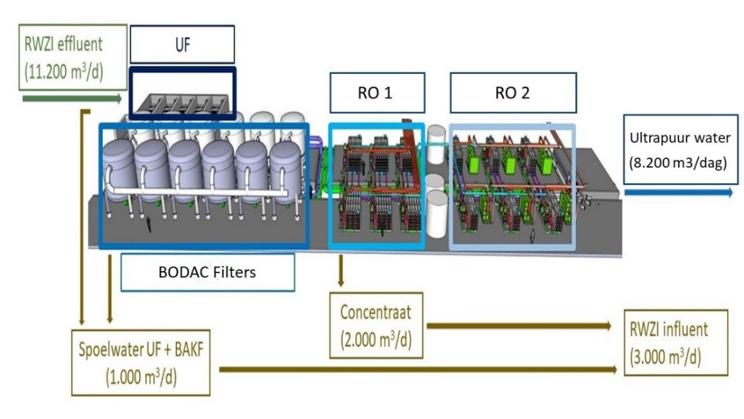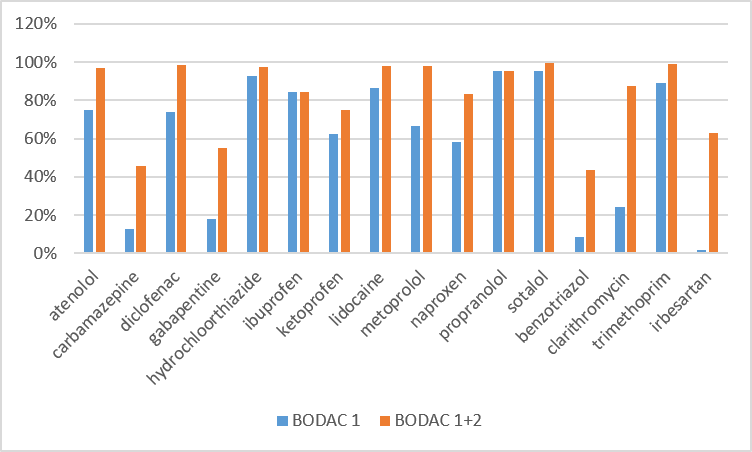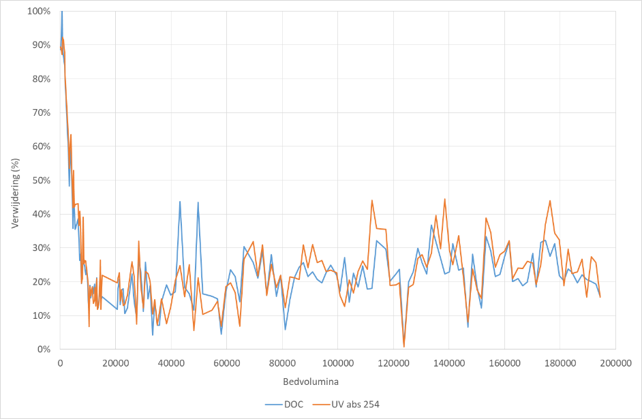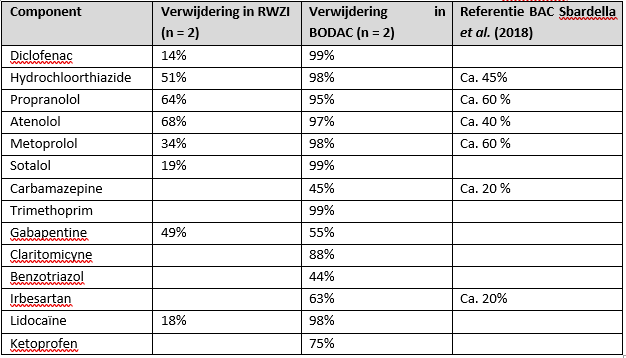From H2O-Online
Download the PDF here.
Since 2010, NieuWater has been producing ultrapure water from the effluent of the Emmen WTTP, which it supplies to the NAM in Schoonebeek to be used as process water. The Biological Oxygen-Dosed Active Carbon (BODAC) filtration, used to pre-treat the water, also appears to be a promising technique for removing pharmaceuticals.
Written by Peter van der Maas (WLN, VHL University of applied sciences), Gerrit Veenendaal (Nieuwater), Jaap Nonnekens (Vechtstromen Water Board), Henk Brink (WMD), Dennis de Vogel (WLN)
Since 2010, NieuWater BV, a joint venture between the Vechtstromen Water Board and Drenthe-based water services provider WMD, has been producing ultrapure water (UPW) at the Emmen WTTP. NieuWater BV can produce up to 8200 m3 of UPW from WTTP effluent every day by means of several treatment steps. Reverse Osmosis (RO) is the main desalination technique, and prior to the RO process, water is filtered with Biological Oxygen-Dosed Activated Carbon, or BODAC, to control the formation of biofouling on RO membranes [1].
This is the third of three articles about the UPW plant at the Emmen WWTP. For the first and second article, click here and here.
In practice, the BODAC technique used in Emmen also appears to remove large amounts of pharmaceuticals from the water. After nine years, the removal rates are still high, despite the fact that the original coal has still not been regenerated.
Removal of pharmaceuticals with BODAC
NieuWater’s BODAC plant is fed with ultra-filtered (i.e. particle-free) WTTP effluent (see figure 1). The BODAC filtration process consists of two steps with an empty bed retention time of 16 (step 1) and 32 (step 2) minutes, respectively. Oxygen is added to the influent of both filtration steps to prevent anaerobic conditions in the BODAC filters. A biofilm then grows around the activated carbon granules. The BODAC filters are backwashed regularly (0.5 to 2 times a week, depending on temperature) to remove any excess biomass, after which the rinsing water is returned to the WWTP. The activated carbon (Norit 830P) was put into service nine years ago and has not been regenerated since.

Figure 1. BODAC pre-treatment before RO, NieuWater UPW plant
Exploratory research by NieuWater has shown that the BODAC system in use in Emmen effectively removes pharmaceuticals (>80%) from the WWTP effluent (see figure 2), even after nine years of filtering, corresponding to approximately 200,000 bed volumes (BV). The carbon is loaded with organic matter, measured as Dissolved Organic Carbon (DOC). The DOC saturation point was reached years ago, after approximately 10,000 bed volumes (BV). Since then, approximately 20% of DOC is removed every year (see figure 3).

Figure 2. Percentage removal of pharmaceuticals with BODAC, two-test averages, December 2018. Orange: total removal (first and second filter), blue: removal in first BODAC filter
The first BODAC filter (16-minute retention time) removes many pharmaceuticals at a rate of more than 70%. After passing through the second filter (i.e. after 16+32=48 minutes), more than 90% of all diclofenac, hydrochorothiazide, metoprolol, lidocaine, propanol, sotalol, trimethoprim and claritomycine is removed from the water. Carbamazepine, gabapentine, benzotriazole and irbesartan are removed, though at a lower rate of 40-70%, see figure 2.

Figure 3. DOC removal and UV absorption in BODAC filters set off against the number of bed volumes
Removal principle
We do currently not have a clear understanding of the underlying principles of how the BODAC filters in Emmen remove pharmaceuticals from water. Though both biodegradation and sorption may play a role, three important comments should be made first:
- Biodegradation: the substances that BODAC manages to remove at a high rate, are only removed to a limited extent in the main WTTP (see table 1). These substances are therefore not readily biodegradable in the main treatment system.
- Sorption on the biofilm: the BODAC biofilm is regularly back-flushed to keep the amount of biological material constant. In principle, this may also remove pharmaceuticals that have been sorbed into or onto the biofilm. On the other hand, sorption to activated sludge does not play a major role in the main treatment system, seeing as pharmaceutical removal is very limited in this system (see table 1).
- Adsorption to activated carbon may play a role, but this is unlikely to explain the removal of drugs after nine years. Sbardella et al. studied the applicability of biological activated carbon with downstream ultrafiltration (BAC-UF) on WWTP effluent [2] and found that the removal of pharmaceuticals through BAC filtration plummeted after approximately 10,000 BV, whereas it had been high for the first 10,000 BV (see table 1). With an eye on these observations, it is unlikely that adsorption in a saturated state (after >> 10,000 BV, as is the case in Emmen) can explain the high degree of pharmaceutical removal by the BODAC filter in Emmen.
As such, there are still many questions regarding the mechanism by which NieuWater’s BODAC filters remove pharmaceuticals. It is possible that the added oxygen, which is injected to prevent anaerobic conditions from arising in the BODAC filters, may play a role. We are currently studying the underlying principles of the removal mechanism in greater detail in cooperation with Wetsus, among other parties.
Table 1. Removal of pharmaceuticals in the Emmen WTTP (main treatment system), NieuWater’s BODAC filters and Biological Activated Carbon (BAC) benchmark according to [2] (pilot scale, removal rate between 9800 – 13,800 bed volumes).

Promising technique
The results presented above show that BODAC filtration, as applied in Emmen, is a potentially promising technique for the post-treatment of WTTP effluent. Within the Micropollutants in Wastewater research programme, supported by the STOWA Foundation for Applied Water Management Research, we are currently conducting a feasibility study into BODAC filtration as a way to remove pharmaceuticals from wastewater. Apart from investigating the pharmaceutical removal rate and
removal mechanism, this study also seeks to explore the exotoxicological effects, the desirability of particle removal and the carbon footprint of BODAC filtration, as well as the costs involved.
References
1. Maas, P. van der, Majoor, E., Dost, S., Schippers, .J (2010). Beheersing
vervuiling RO membranen door biologische actiefkoolfiltratie. H2O (18),
41-44.
2. Sbardella, L., Comas, J., Fenu, A., Rodriguez-Roda I, Weemaes M. (2018).
Advanced biological activated carbon filter for removing pharmaceutically
active compounds from treated wastewater. Science of the Total
Environment (636), 519–529.